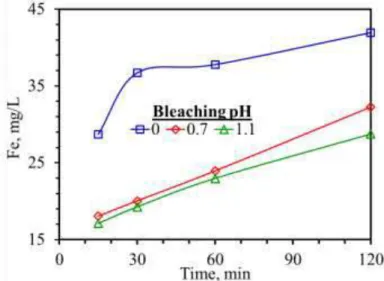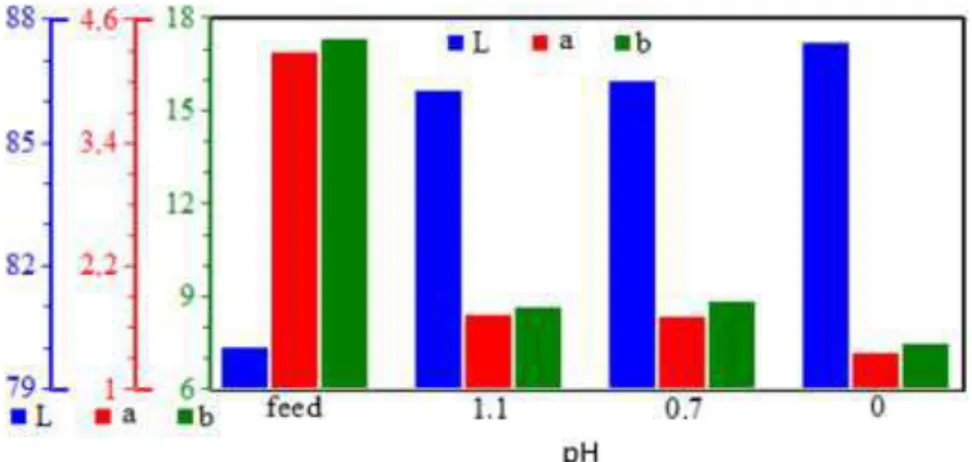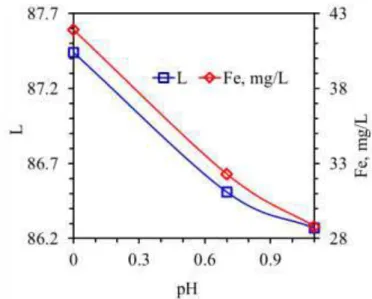REJECTION OF IRON COLORING IMPURITIES OF QUARTZ ORE BY SULFURIC ACID BLEACHING
M.M.A Mohammed 1,*, T. Güler 1, E. Polat 1
1 Muğla Sıtkı Koçman University, Dept. of Mining Engineering
(*Corresponding author: mumohammed@mu.edu.tr) ABSTRACT
Quartz purification by bleaching methods has taken great interest for several decades both for conventional and high technology applications like production of optical fibers, construction of silicon cells and semiconductors, where physical methods succeeds partially. This work was performed to determine the effect of pH on the Fe rejection rate and brightness of quartz in oxidizing acid environment created by sulfuric acid. Leaching tests were conducted for 120 minutes at three different pH values (pH 0, pH 0.7, pH 1.1) in an open flow system agitated pulp condition. Sample was taken from metal loaded underflow leach liquor at 15th, 30th, 60th and 120th minutes of leaching to determine Fe dissolution rate by inductively coupled plasma mass spectrometry (ICP-MS). Quality of leached samples were determined by color analyses. Experimental works revealed that quartz-bleaching rate depends on mineralogical composition of ore. Tested ore sample could not be bleached sufficiently in oxidizing environment due to presence of hematite and mica minerals, which requires highly acid reducing condition.
Keywords: Quartz bleaching, sulfuric acid, color analysis, Fe-rejection INTRODUCTION
Quartz (SiO2) is the main raw material of several industrial applications especially for glass and ceramic production. Quality of quartz ore depends on the rates of impurities contained in it. Common impurities are hematite (Fe2O3), biotite (K(Fe, Mg)3AlSi3O10), rutile (TiO2), titanite (CaTiSiO5), albite (NaAlSi3O8) and ilmenite (FeTiO3) (Güler, 2015; Ubaldini et al., 1996; Zhang et al., 2012). These minerals reduce the quality of quartz ore by decreasing brightness: Ferric (Fe3+) impurities are known to impart an orange color. Ferrous (Fe2+) iron containing impurities decrease brightness of quartz, and Fe2+ ion converts into ferric one in oxidizing environment during firing in the conventional ceramic applications. In general, iron impairs the transparency of colorless container glass and high-quality glass (e.g. for tableware and optical glass), and transmission in optical fibers (Ubaldini et al., 1996; Veglio et al., 1998).
The brightness of the ore is defined by the degree of whitening that can be measured by the CIELAB color index (L, a, b) using a colorimeter. The values “L”, “a” and “b” are used as measures of purity for quartz ore. “L” scale interprets the degree of whiteness in a range from 0 for pure black to 100 for diffuse white. Positive value for scale “a” represents red color while negative value is the measure of greenness. The scale “b” show yellowness for the positive value (+b) and blueness for negative (-b) one (Field, 2004; Green, 1999).
Coloring impurities are separated from quartz ore to improve its brightness by exploiting the chemical and physical properties. Physically, as the first step of ore beneficiation, quartz ore is purified by utilizing the color property differences of minerals by hand sorting to remove the dark-colored coarse particles from the ore (Dehler, 2006). Magnetic separation is applied for the rejection of magnetic impurities like hematite, ilmenite and mica minerals according to the magnetic susceptibility difference between quartz and these coloring impurities (Al-Maghrabi, 2004; Arvidson, 1999; Hacıfazlıoğlu, 2011).
Magnetic separation is the commonly applied method due to its simplicity and effectiveness. Another physical beneficiation method is flotation, in which coloring impurities are generally floated. Vidyadhar et al (2014) studied on the flotation separation of quartz from hematite. They pointed out from reverse flotation study that maximum hematite flotation recovery was observed at acidic pH with sulfate, neutral pH with oleate, and at basic pH about 9.5 with C12 amine. Sayılgan & Arol (2003) explained both cationic and anionic floatability of quartz by alkalinity of water. Mowla et al (2008) studied the effects of various operating parameters such as type and concentration of collectors, type of acid, pH, conditioning time, solid-in-pulp concentration, particle size and temperature on the hematite removal efficiency by reverse flotation. They showed that the separation of hematite from silica sand by reverse flotation was possible and good selectivity could be achieved.
Quartz ore is also purified chemically by dissolving of the metallic impurities from the surface of the ore, which is called bleaching. Quartz bleaching is performed to remove the metallic impurities to obtain high purity quartz for special applications like manufacturing of solar panels, electronic batteries and other advanced technological products (Akcil &Tuncuk, 2006; Huang et al., 2013; Tuncuk & Akçil, 2016). Zhou (2005) leached about 75% of coloring impurities including Al, Ti and Fe by using 28.6% HF acid at 120 °C. Zhang et al (2012) stated that phosphoric acid was a good leaching agent for iron removal from quartz sand because of its leaching efficiency up to 77.1%. Shen and Peng (2008) studied the removal of iron impurities from Gaoping silica sand using 0.5 M H2SO4. They could remove 48.2% of iron impurities of silica sand by 96 h leaching. Jin et al. (2004) started from dressing mineral rock to raise the leaching efficiency, by first roasting the rock to 850 °C. Then, it was quenched by cold water to obtain broken rock into small pieces in a loose way; the broken rocks were ground to 200 μm, and leached by H2SO4 at 250 °C for 40 min. They finally obtained the leaching percentage of 96.5% of iron oxide. Tuncuk & Akçil (2016) indicated that quartz was highly purified by leaching with sulfuric acid (H2SO4) in the presence of reducing agents (oxalic acid, citric acid, and glucose). Huang et al (2013) explained the leaching efficiency with particle size: it decreased for extremely fine silica sand with increasing stirring speed whereas leaching efficiency of coarse particles increases with increasing stirring speed or higher ultrasonic power.
This study was conducted to determine the relationship between the rejection rate of metallic impurities and whitening level of quartz ore. Quartz bleaching was performed by sulfuric acid at different pH values in an atmospherically sealed reactor. Agitated tank leaching was applied in a continuous flow of leaching agent in an open flow system.
MATERIALS AND METHOD Materials
Quartz ore sample was provided by Mikroman Company located in Yatağan region in Muğla, Turkey. Sample was -300 µm size with L, a and b values 81.09, 3.50 and 15.53, respectively. High purity analytical grade sulfuric acid (H2SO4) is used as bleaching agent (Merck, 95%). Agitated tank leaching was applied using a 1000 ml plastic reactor. Agitation was supplied by a mechanical stirrer (M-TOPS MS-3020D) in which teflon coated impeller was used. Reactor bottom was designed as to allow squeezing under gravity through filter paper coated screen surface. Percolation rate through filter paper coated bottom screen surface was adjusted to 2.57 ml/min squeezing rate using threefold filter papers.
reactor, and equivalent volume of metal loaded leach liquor was allowed to squeeze from bottom under gravity to maintain the solid rate in the reactor. Agitation was applied at 350 rpm for 120 minutes. Chemical composition of leach liquors taken from reactor at 15th, 30th, 60th and 120th minutes of leaching were analyzed by inductively coupled plasma mass spectrometry (ICP-MS). At 120 minutes, leaching was ceased. Then, sample was taken from reactor, and subjected to thorough washing. Bleached and washed quartz sample was dried in a furnace (Memmert UNB400) at 105°C. Color analyses was made on dried samples using a colorimeter (CNP Spec CS-10) to determine L, a and b values of the sample.
RESULTS AND DISCUSSCIONS
Quartz bleaching tests were conducted in an open-flow system agitated tank reactor. Dissolution rate of iron was monitored by sampling the metal loaded underflow of reactor (Figure 1). Rejection rate of iron from quartz ore was identified to increase at all the tested pH values up to 30th minute of leaching. Further increase in the Fe rejection was seen as leaching going on for the cases of pH 0.7 and pH 1.1 drawing a linear relationship with leaching time. Dissolution rate of iron could not reach to the equilibrium in the tested period. On the other hand, sharp increase in the dissolution of iron was observed at pH 0 up to 30th minute of leaching, and then continued to increase slightly.
Figure 1. Relationship between leaching time and Fe rejection rate in the leach liquor
Brightness tests were performed to determine the color response of such rejection rates (Figure 2). Color index values drew similar trends. The “L” value increased sharply from 81.09 for ore sample to 86.27 by bleaching at the highest tested pH (pH 1.1). However, whiteness could not be improved significantly by increasing the acidity. Similar results were also observed both for “a” and “b” values. They decreased sharply first, and then gradually. Obtained data revealed that coloring impurities could be rejected by sulfuric acid only at a limited rate.
Figure 2. Effect of bleaching pH on the brightness values of quartz ore
Iron dissolution is known to be a pH and potential dependent process (Figure 3). Fe coming from Fe-oxides can be dissolved by decreasing pH and Eh (Alvarez et al., 2006). H2SO4 is a powerful pH regulator releasing two H+ ions. Protonation of surface sites has been proposed to weaken Me–O lattice bonds in the dissolution of iron oxides, accelerating the rate of detachment (Stone & Morgan, 1987; Chiarizia and Hortwiz, 1991). However, presence of excess H+ ions in the leaching system also means the increased rest potential as going towards lower pHs. Leaching system rest potential was measured around 750 mV. This potential value is closer to the stability limits of Fe. Then, the solubility of iron was proposed to adversely affected at highly oxidizing environment. Moreover, Fe dissolution is also a phase dependent process. Veglio et al (1998) demonstrated that iron in the micaceous fraction was extremely difficult to remove by H2SO4 leaching. Cepriá et al (2003) proposes that goethite (FeOOH) dissolves under oxidizing environment while Fe dissolution from hematite and maghemite like minerals requires reducing condition. Lee et al. (2007) stated that goethite dissolved more rapidly than ferric oxide (Fe2O3).
and 1.71, respectively. Sharp decrease was measured at pH 0, where “a” value was 1.36. On the other hand, “b” value decreased with a more linear tendency (Figure 6) than that of curve “a” by increasing acidity, where the amount of iron ion in the leach liquor increased. The decrease in “b” value was not so high from pH 1.1 to pH 0.7: these values were measured as 8.83 and 8.64, respectively. The “b” value was 7.47 for pH 0. The obtained curves – increasing trend of “L” curve and decreasing “a” and “b” curves – indicate that whiteness of quartz ore increases almost proportionally with an increase in the rejection rate of Fe coloring impurities. However, lower rates of changes of “a” and “b” values at high pH values were attributed presence of Fe-containing minerals as coatings of quartz particles as locked ones and free particles. Surface coatings were thought to be leached in weakly acid pulp condition whereas free Fe-impurities could not completely be leached during leaching.
Figure 4. Effect of leaching pH on Fe dissolution rate and color index “L” values
Figure 6. Effect of leaching pH on Fe dissolution rate and color index “b” values
CONCLUSIONS
Quartz bleaching by sulfuric acid was investigated in a stirred pulp condition to determine the relationship between Fe rejection rate and color response. From experimental works, following conclusions were drawn:
- Iron rejection rate is pH and time dependent phenomenon: increasing the acidity results in an increase in Fe dissolution rate reaching equilibrium concentration in shorter period of leaching. - Quartz ore could be bleached up to limited brightness values by agitated tank sulfuric acid
bleaching process. Increasing acidity could not sufficiently improve the brightness.
- Mineralogical composition determines the dissolution rate of iron from quartz ore. Major Fe containing impurities – hematite and mica minerals – could not be leached by sulfuric acid in oxidizing environment.
- Brightest quartz was obtained at pH 0 with color index responses for “L”, “a” and “b” as 87.50, 1.36 and 7.47 from a quartz ore sample having color values 81.09, 3.50 and 15.53 with sulfuric acid bleaching, respectively.
REFERENCES
Akcil, A., & Tuncuk, A. (2006). An overview of chemical and biological methods in the purification of kaolins. Journal of Clay Science and Technology, 2, 59-69.
Al-Maghrabi, M.N.H. (2004) Improvement of low-grade silica sand deposits in Jeddah area. JKAU: Eng.
Sci., 15(2), 113-128.
Alvarez, M., Rueda, E.H., & Sileo, E.E. (2006). Structural characterization and chemical reactivity of synthetic Mn-goethites and hematites. Chemical Geology, 231, 288–299.
Anonymous (2018). Pourbaix Diagrams. In: Inorganic Chemistry,
(https://chem.libretexts.org/Bookshelves/Inorganic_Chemistry/Book%3A_Inorganic_Chemistry_(Wi kibook)/Chapter_04%3A_Redox_Stability_and_Redox_Reactions/4.5%3A_Pourbaix_diagrams). Arvidson, B.R. (1999) Advances in rare earth magnetic drum separators for heavy mineral sands
Dehler, M. (2006). Optical sorting of quartz gravel to reduce the iron content. Aufbereitungstechnik, 47(8/9), 6.
Field, G.G. (2004). Color and its reproduction. Pittsburgh, PA: Graphic Arts Technical Foundation. Green, P. (1999). Understanding digital color (2nd ed.). GATF Press.
Güler, T. (2015). Report on the chemical and mineralogical characterization of quartz samples supplied by Mikroman Mining. Muğla: Muğla Sıtkı Koçman University, Faculty of Engineering, Department of Mining Engineering.
Hacıfazlıoğlu, H. (2011). Silis kumunun zenginleştirilmesinde kullanılan yöntemler ve flotasyon ile manyetik ayırma yöntemlerinin demir giderimi bakımından karşılaştırılması, Madencilik, 50(3): 35-48 (in Turkish).
Huang, H., Li, J., Li, X., & Zhang, Z. (2013). Iron removal from extremely fine quartz and its kinetics,
Separation and Purification Technology, 108, 45–50
Jin, D.B., Zhang, X.M., & Zou, W.W. (2004). Technical study on processing highly püre quartz sand. Guide for non-metallic ores industry. Sinica, 4, 44–48.
Lee, S.O., Tran, T., Jung, B.H., Kim, S.J., & Kim, M.J. (2007). Dissolution of iron oxide using oxalic acid.
Hydrometallurgy, 87, 91–99.
Mowla, D., Karimi, G., & Ostadnezhad, K. (2008). Removal of hematite from silica sand ore by reverse flotation technique. Separation and Purification Technology, 58(3), 419-423.
Sayılgan, A., & Arol, A.İ. (2003). Effect of alkalinity on flotation behavior of quartz. In: 18th International Mining Congress and Exhibition of Turkey, Antalya, 381-384.
Shen, X.M., & Peng, Z.S. (2008). Study on removal of iron from Gaoping quartz. J. Xiangtan Univ. (Nat.
Sci.), 30, 78–79.
Stone, A.T., & Morgan, J.J. (1987). Reductive dissolution of metal oxides. In: Stumm, W. (Ed.), Aquatic Surface Chemistry. Wiley, New York.
Tuncuk, A., & Akcil, A. (2016). Iron removal in production of purified quartz by hydrometallurgical process. International Journal of Mineral Processing, 153, 44-50.
Ubaldini, S., Piga, L., Fornari, P., & Massidda, R. (1996). Removal of iron from quartz sands: A study by column leaching using a complete factorial design. Hydrometallurgy, 40(3), 369-379.
Veglio, F., Passariello, B., Barbaro, M., Plescia, P., & Marabini, A.M. (1998). Drum leaching tests in iron removal from quartz using oxalic and sulphuric acids. International Journal Mineral Processing, 54(3-4), 183–200.
Vidyadhar, A., Kumari, N., & Bhagat, R.P. (2014). Adsorption mechanism of mixed cationic/anionic collectors in quartz-hematite flotation system, Mineral Processing and Extractive Metallurgy Review, 35(2), 117-125.
Zhang, Z., Li, J., Li, X., Huang, H., Zhou, L., & Xiong, T. (2012). High efficiency iron removal from quartz sand using phosphoric acid. International Journal of Mineral Processing, 114-117, 30-34.



